By John Mangels
Science Communications Officer
The Museum’s Wade Gallery of Gems & Jewels is filled with amazing specimens: glittering diamonds, bottle-green emeralds, iridescent opals, and sapphires the color of a twilight sky.
But my favorite is a plain-looking lump of grayish rock, about the size of a child’s fist.
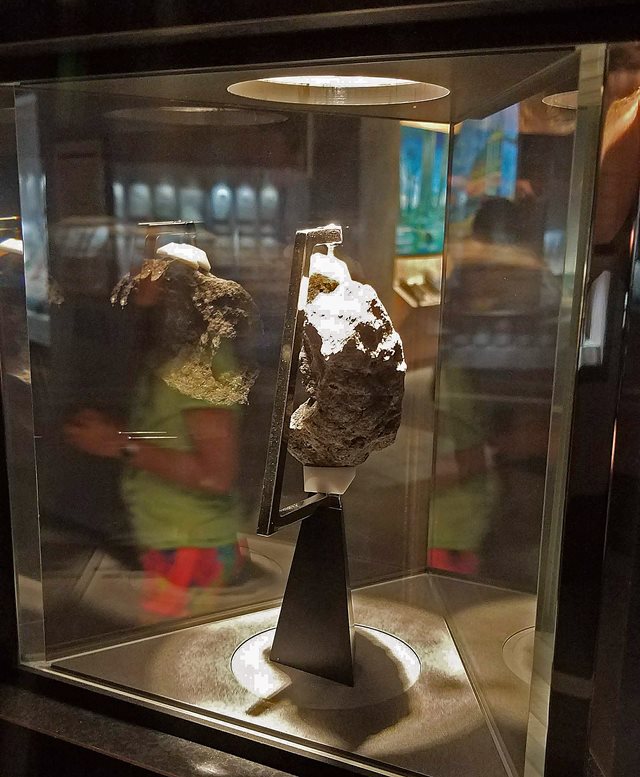
Its surface is rough, angular and pitted. You’d never mistake it for a gemstone. And yet, it’s far more precious than any other stone in the gallery. Two adventurers risked their lives and trekked half a million miles to find it, on an expedition that cost
$10 billion in today’s dollars.
I’ve been thinking a lot lately about that rock. The man who first spotted it on the edge of a lunar crater 49 years ago and brought it back to Earth — Apollo 12 astronaut Alan Bean —
died a few days ago, on May 26.
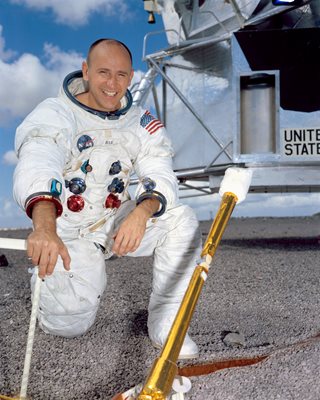
Bean, 86, was the fourth of a dozen pioneering Apollo astronauts who explored the Moon’s surface in the 1960s and ‘70s. Only four remain alive.
“Alan Bean is one of the great renaissance men of his generation — engineer, fighter pilot, astronaut and artist,” Apollo 17 lunar module pilot and geologist Harrison Schmitt
said in Bean’s NASA obituary.
The 75 pounds of lunar rocks and soil samples that Bean and Apollo 12 commander Charles “Pete” Conrad collected during their nearly 8-hour stay — which includes the specimen on long-term loan from NASA to the Museum — are “a scientific gift that keeps on giving today and in the future,” said Schmitt.
The Apollo 12 samples, along with those from the other five lunar landing missions, have greatly added our understanding of the Moon’s history and geology.
An Early Close Call
Bean, Conrad and Apollo 12 command module pilot Richard Gordon almost didn’t make it to the Moon. Shortly after their Saturn V rocket blasted off from Florida’s Kennedy Space Center during a rainstorm on Nov. 14, 1969, it was hit not once, but twice, by lightning.

The strikes knocked out much of the flight’s electrical and navigation systems, and the fuel cells that powered the astronauts’ spacecraft. The
failures could have aborted the mission before it reached orbit.
But Bean, Apollo 12’s systems engineer, toggled an obscure switch that helped reset the electronics and restore the power supply. He also used his knowledge of star charts to help Gordon and Conrad manually aim the spacecraft for the Moon, overcoming the temporary loss of the automated navigation system.
“What a way to start,” he quipped.
Getting Down to Work
Apollo 12 was meant to begin NASA’s systematic, scientific exploration of the Moon.

The first lunar-landing mission, Apollo 11, four months earlier, was mainly a proof-of-concept flight meant to fulfill President John F. Kennedy’s 1962
goal, “before this decade is out, of landing a man on the Moon and returning him safely to the Earth.” Apollo 11 astronauts Neil Armstrong and Edwin “Buzz” Aldrin spent only 2½ hours walking on the lunar surface and ventured no more than a football field’s length from their spacecraft. The landing site, in the Sea of Tranquility, was chosen because it was relatively free of craters and boulders, improving the chances of a safe touchdown.
Bean and Conrad would spend twice as much time on the surface as their predecessors, and would be working in a more geologically interesting area — the Ocean of Storms, a vast, ancient impact crater later filled in by flows of molten volcanic lava that cooled and solidified into rock.
Why Study the Moon?
The Moon was and is of great interest to scientists because it preserves an early history of our solar system that can’t be found on Earth.
Our planet’s active geology — its restless tectonic plates and the forces of erosion — constantly scour and obliterate the oldest surfaces. Not so on the Moon, where there is no atmospheric wind or flowing water, and far less seismic activity. Major portions of the Moon’s crust and rocks are considerably older than their terrestrial counterparts.
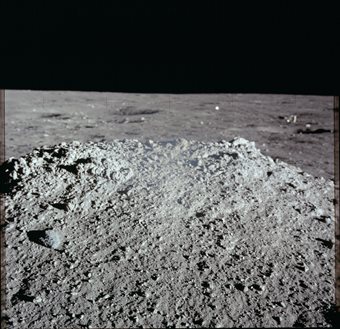
That means the Moon basically functions as an archive. Its ancient crust preserves a record of the geologic events that occurred as the Moon, Earth and the solar system’s other inner planets formed from interstellar rubble 4.5 billion years ago. Its craters are a testament to the intense meteorite bombardments that followed. And its dusty surface holds a chemical record of the radiation spewed by our Sun throughout its lifespan, which can help to decipher climate changes on Earth.
The Moon “moves through space as an ancient text,” astronaut and geologist Schmitt once said, “recording in its soils much of immediate importance to man’s future well-being.” It is “a pitted and dusty window into Earth’s own origin and evolution.”
Scientists had gleaned some information from previous robotic lunar orbiters and landers. But the Apollo astronauts would be able to directly observe on the surface, and collect rocks, soil and core samples for geochemical analysis back on Earth. They would plant seismometers and take other measurements to probe the Moon’s interior. The exploration missions would provide “ground truth” that would confirm or challenge existing ideas about the solar system’s evolution.
Astronauts as Geologists
As NASA recounts in the lunar landing program’s
official history, “geologists had high hopes for the Apollo 12 crew.” Bean and Conrad had gone through an upgraded training program that prioritized gaining an understanding of the landing site’s overall geology rather than randomly picking up interesting rocks. They’d spent more than 200 hours in the field, including time in Hawaii’s lava beds, an analog for the Moon’s Ocean of Storms.
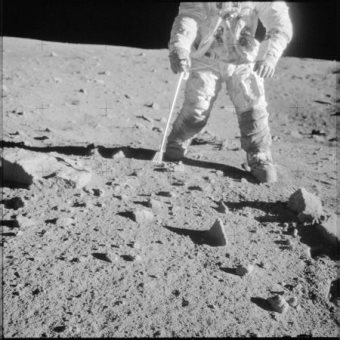
“We talked with (the geologists) before we went about (the fact that) the main objectives of the geology wasn't to go out and grab a few rocks and take some pictures, but to try to understand the morphology and the stratigraphy ... of the vicinity you were in,” Bean told author W. David Compton. “Look around and try to use your head along those lines.”
It was easier said than done.
Bean and Conrad later admitted that the Moon’s impact-scarred surface and the lack of familiar visual clues made it hard for them to do on-the-spot geologic interpretation. “I think even a trained geologist would have trouble doing a whole lot of field geology that way on the Moon,” Conrad remarked.
But they managed to collect a bevy of interesting rocks, including a two-pound specimen labelled
No. 12055, a piece of which is on display at the Museum.
Finding 12055
“Hey, you kicked over a rock that had a white bottom – quite a bit different than the top,” Bean said to Conrad upon first spotting the stone on Nov. 20, 1969, as the astronauts prowled the rim of Head Crater. “Pete, maybe you want it.” (This video contains a recording and photos of 12055’s discovery.)
Analysis back at NASA’s Lunar Sample Lab in Houston showed that 12055 is 3.2 billion-year-old chunk of solidified lava, or basalt, one of three general lunar rock types, all of which formed in high-temperature conditions.
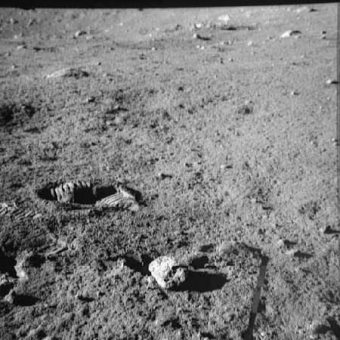
The other types are anorthosites — at more than 4 billion years old, the most ancient lunar rocks, formed when blobs of mineral-rich feldspar crystallized and floated to the surface of the primitive Moon’s global magma ocean — and breccias, mashups of the other rock types welded together by volcanic eruptions, meteorite impacts or other disruptive forces.
The surface of 12055 is pockmarked with small cavities, or “vugs,” left by gas bubbles as the lava sheet cooled and formed a frozen ocean of dark-colored basalt. Eventually, the rock was blasted loose from deep within the lava bed by a meteorite impact. It lay on the surface for 330 million years, until Bean spotted it.
The rock’s composition reflects the minerals of the Moon’s molten upper mantle, where it originated: magnesium, iron, aluminum, silica, titanium and other trace elements.
The Rocks’ Legacy
The rocks and soil samples collected by Bean, Conrad and the other Apollo astronauts didn’t answer the biggest question on scientists’ minds: how the Moon originated. Researchers had hoped the lunar materials’ geochemical makeup would serve as a fingerprint, enabling their source to be identified.

A leading theory holds that the Moon resulted from a giant collision between the primitive Earth and a Mars-sized proto-planet, with the Moon forming from the impact debris. If that were the case, presumably the Moon’s chemistry would be different from Earth’s, instead containing a mix of material from Earth and the impactor.
But the Apollo samples
showed a remarkable geochemical similarity between Earth and Moon. While that doesn’t necessarily rule out an impact-based genesis — the Earth and Moon could have
formed simultaneously, from the debris of an even bigger collision between two planetary bodies, according to a NASA scenario — the Moon rocks demonstrate that the Moon’s origin was complicated.
Likewise, the lunar specimens and surface data gathered by the Apollo missions paint a complex picture of the Moon’s evolution and early history, with evidence of a semi-liquid core, a fleeting magnetic field and spasms of volcanic eruptions in the past, and weak but detectable “moonquakes” that still occur today.
“Apollo produced a store of scientific treasure whose value, although recognized, has only begun to be exploited by the scientific community,” Compton’s history of the program concluded. “The Apollo samples now stored on Earth allow lunar research to continue, based on new concepts and using improved techniques and instruments.”
Acquiring the Museum’s Rock
Although the primary purpose of collecting lunar rocks and soil was for research, NASA has made a small portion of the 840 pounds of Apollo specimens available for public display and education. When the Museum began planning its new Reinberger Hall of Earth and Planetary Exploration in the late 1990s, astronomer and Mueller Observatory Manager Clyde Simpson led an effort to secure a Moon rock for the exhibit. He enlisted the support of area educators and astronomy groups as well as Cleveland’s NASA Lewis (now John Glenn) Research Center, whose visitors center already had its own Moon rock.
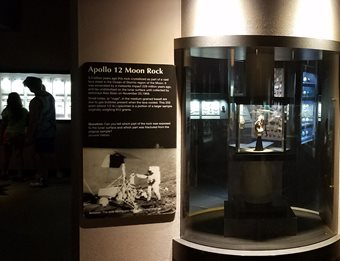
“We were one of the first natural history museums to incorporate planetary geology” in exhibits, Simpson said. “I had my heart set on getting a Moon rock on long-term loan” from NASA. “We pulled out all the stops.” The Museum petitioned for specimens of all three lunar rock types, but ultimately received a basalt sample — a chunk cut from Apollo 12’s 120555 rock. Other pieces of 12055 are on public display in the
Philippines and in
Bonn, Germany.
A total of 66 museums and planetariums around the world have Moon rock samples.
In January 1999, Bean visited the Museum to speak about his astronaut experiences and to promote his book
“Apollo: An Eyewitness Account.” By then, he had resigned from NASA to devote full time to his
artistic career, creating paintings of the Moon and his fellow Apollo astronauts. The artworks are sprinkled with Moon dust from his spacesuit and bits of the Apollo 12 command module’s heat shield and gold foil insulation.
Bean “was the most charming, nice guy,” Simpson remembers. And he had a sense of humor. Or a great memory. When the former astronaut entered the Wade Gallery and spied specimen 12055, one of the dozens of samples he and Conrad had plucked from the Moon’s surface 30 years earlier, Bean smiled and said, “I remember that rock.”
Go back to all blogs